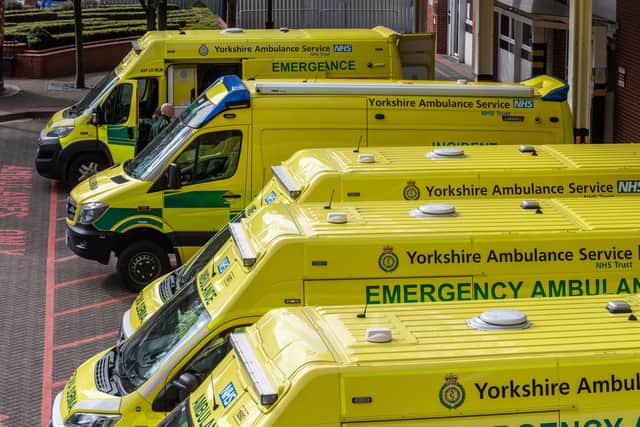Ambulance waiting times: New NHS figures show long it takes for paramedics to reach patients in Yorkshire
and live on Freeview channel 276
Patients with life-threatening conditions waited an average of nine minutes and 30 seconds for an ambulance last month, missing the target of seven minutes.
And the NHS figures show it took paramedics an average of 43 minutes to reach patients with category two emergencies, such as suspected heart attacks or strokes - far above the 18-minute target.
Advertisement
Hide AdAdvertisement
Hide AdEvery ambulance trust in England missed response time targets for all four categories of call-out. For the least serious calls, people in Yorkshire were left waiting an average of two hours and 41 minutes.


For category three calls, there was an average wait of two hours and 17 minutes.
Yorkshire Ambulance Service has urged to only call 999 if their condition is serious or life-threatening, as it experiences high demand.
Dr Tim Cooksley, president of the Society for Acute Medicine, said the situation across England “remains unacceptable”.
Advertisement
Hide AdAdvertisement
Hide AdHe said: “Increasingly people will themselves, or had a friend or family member who has, experienced a long wait for emergency care or be on an NHS waiting list.
“Performance data now routinely illustrates that patients are continuing to experience overcrowding in acute care settings with flow throughout the system impaired.
“Patients are being stuck for extortionately long periods in emergency departments and acute medical units (AMUs) which results in worse patient outcomes.
“Due to this, paramedics are then stuck unable to transfer their patients into hospitals and get back on the road, resulting in 999 patients being left at home for longer periods without clinical assessment and treatment, driving public concern that they may not get an ambulance at their time of most need.”
Advertisement
Hide AdAdvertisement
Hide AdIt was also the busiest June ever for 999 calls across England, with almost 900,000 answered, and the number of life-threatening category one call-outs reaching a record high for the month of June, of 79,436.
In a statement, a spokesperson for the Yorkshire Ambulance Service said: "An extremely high volume of calls is currently having a significant impact on both our 999 and NHS 111 operations.
“We have taken the decision to move to REAP Level 4, our highest level of escalation, and while the situation is being managed in line with the plans that we have in place to protect our core services, unfortunately there are patients who are facing delays and we are very sorry that we are unable to respond to them as quickly as we would like.
Advertisement
Hide AdAdvertisement
Hide Ad“All emergency calls are categorised according to the nature of a patient’s illness or injury and those in a life-threatening condition are always prioritised. It’s important that members of the public only call 999 for an ambulance when it is a serious or life-threatening emergency. This will help us to focus our efforts on our most poorly patients.
“You can also help us by not calling back to check where the ambulance is as we need those phone lines to be free for those in a life-threatening condition. However, if the condition of the patient changes or if you feel you no longer need an ambulance, it’s important that you let us know.
“For anyone with less serious illnesses and injuries, they should consider self-care, their local pharmacy, GP surgery, urgent care centre or making their own way to the emergency department. Our NHS 111 service is also available online at 111.nhs.uk or by calling 111.
“We will continue to monitor the situation closely and thank all our hard-working staff and volunteers for their efforts at this challenging time.”
Comment Guidelines
National World encourages reader discussion on our stories. User feedback, insights and back-and-forth exchanges add a rich layer of context to reporting. Please review our Community Guidelines before commenting.
